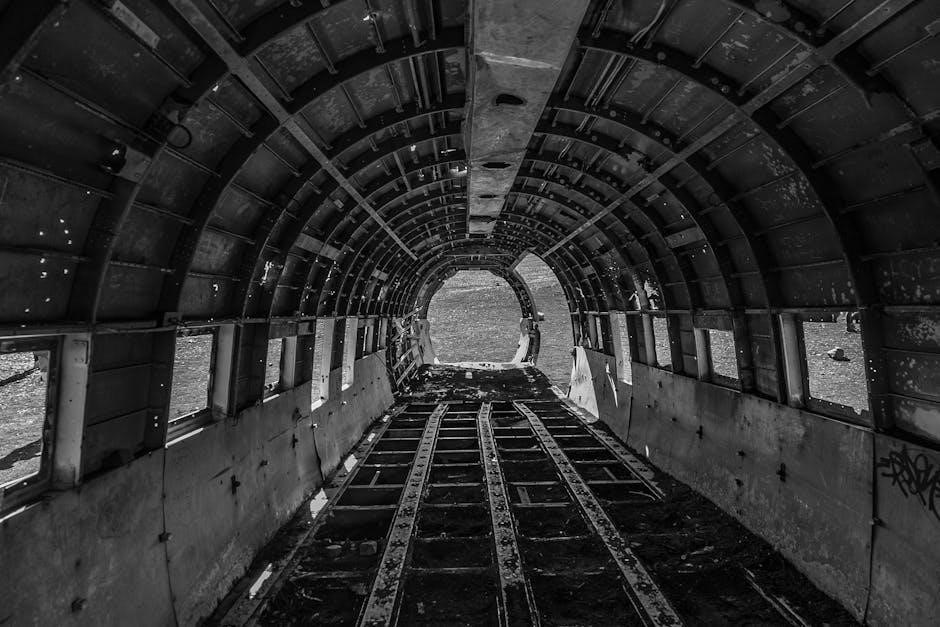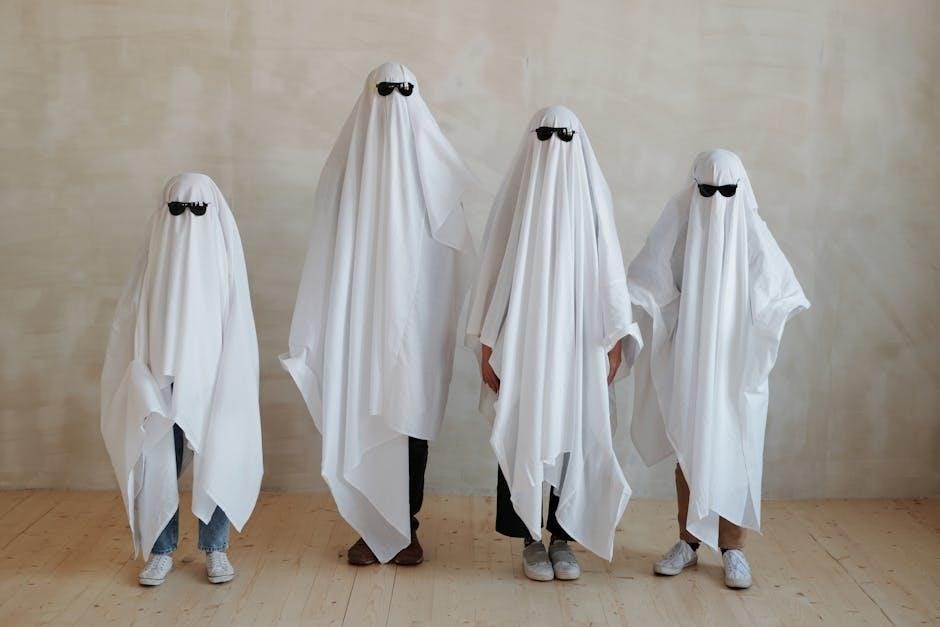This guide provides insights into the themes, content, and suitability of Ghost in the Shell for children, helping parents make informed decisions about viewing the film.
Overview of the Franchise and Its Relevance
Ghost in the Shell is a groundbreaking cyberpunk franchise that originated in Japan, spanning manga, anime, and live-action films. The 1995 anime film is a seminal work, exploring themes of consciousness, humanity, and technology. Its influence is evident in global pop culture, inspiring countless films and series. The 2017 live-action adaptation, starring Scarlett Johansson, introduced the story to new audiences, blending stunning visuals with philosophical questions. Both versions delve into existential themes, making the franchise a cultural touchstone. Parents should be aware of its mature content, including violence and complex ideas, while appreciating its intellectual depth and relevance in a hyper-connected world. Rated PG-13, it’s a thought-provoking experience for mature viewers.
Importance of Understanding the Content for Parents
Understanding the content of Ghost in the Shell is crucial for parents to assess its suitability for children. The franchise explores mature themes like existentialism, consciousness, and the ethics of technology, which may require parental guidance. Scenes of stylized violence, occasional nudity, and intense action can be unsettling for young viewers. Additionally, complex philosophical ideas might spark questions about identity and humanity, encouraging open discussions. Parents should evaluate their child’s maturity level and sensitivity to such themes before allowing them to watch either the anime or live-action versions. This guide helps parents make informed decisions to ensure a safe and enriching viewing experience.

Age Appropriateness and Ratings
Ghost in the Shell is rated PG-13 for stylized violence and mature themes. It is not suitable for young children due to its complex content and action sequences.

PG-13 Rating: What Parents Need to Know
The PG-13 rating for Ghost in the Shell reflects its stylized violence, mild nudity, and mature themes. While the film avoids excessive gore, scenes like a character’s head explosion and intense action sequences may disturb sensitive viewers. Nudity is present but not sexual in nature. Profanity is minimal, and the focus remains on philosophical and technological concepts. Parents should consider their child’s sensitivity to violence and complex ideas before allowing viewing. The rating balances the film’s artistic style with its mature content, making it suitable for teens but potentially unsuitable for younger audiences;
Recommended Age for Viewing
The recommended age for viewing Ghost in the Shell is 13 years and above, aligning with its PG-13 rating. The film’s themes, action violence, and mild nudity make it suitable for mature teenagers. While younger viewers may be drawn to its futuristic visuals, parents should consider their child’s sensitivity to intense scenes and complex ideas. The movie’s philosophical and technological concepts may appeal more to older teens and adults. As with any PG-13 film, parental discretion is advised, especially for younger or sensitive viewers who may find certain sequences disturbing.
Maturity Levels and Viewer Discretion
Maturity levels vary among viewers, but Ghost in the Shell demands discretion due to its complex themes and some intense content. While the film is rated PG-13, its exploration of existential questions and identity may resonate more with older audiences. Parents should assess their child’s ability to handle violence, mild nudity, and philosophical discussions. The movie’s stylized action and futuristic elements may appeal to younger teens, but sensitive viewers might find certain scenes unsettling; Viewer discretion is key, ensuring that only those prepared for mature themes and visuals watch the film. This balance is crucial for a meaningful viewing experience.

Content Warnings and Concerns
Ghost in the Shell contains stylized violence, mild nudity, and intense scenes, including explosions and disturbing distortions, which may unsettle younger or sensitive viewers, despite its PG-13 rating.
Violence and Action Scenes
Ghost in the Shell features intense action sequences, including explosions, gunfire, and hand-to-hand combat. While the violence is stylized, scenes like a character’s head exploding and cyborgs crashing through structures may be unsettling for younger viewers. The film’s PG-13 rating reflects moderate violence, but parents should consider their child’s sensitivity to such content. The action is fast-paced and visually striking, with a focus on futuristic combat and high-stakes chases. Despite the lack of excessive blood, the sheer intensity of these scenes could be inappropriate for very young audiences, making parental discretion essential.

Nudity and Sexual Content
Ghost in the Shell contains some nudity, particularly in the 1995 anime, where brief scenes of naked characters appear. However, these moments are not sexual in nature and serve more for thematic or developmental purposes. The 2017 live-action film also includes limited nudity, but it is similarly non-explicit. While not overly explicit, parents should be aware of these elements when deciding if the content is suitable for their child. The overall focus remains on the story’s cyberpunk themes rather than sexual content, but discretion is advised based on individual sensitivity levels. The PG-13 rating reflects this moderate approach to such scenes.
Language and Profanity
The Ghost in the Shell series generally features mild language and profanity, though some scenes may include occasional strong words. The 1995 anime has minimal explicit language, while the 2017 live-action film keeps profanity restrained, reflecting its PG-13 rating. Dialogues are often intellectual and thematic, focusing on existential and technological discussions rather than relying on heavy cursing. However, parents should remain cautious as some phrases may still be inappropriate for younger audiences. The overall use of language is moderate, balancing mature themes with accessibility for teen viewers. This aspect, while not a major concern, warrants parental discretion based on individual sensitivity levels and age appropriateness.
Frightening and Intense Scenes
Ghost in the Shell contains scenes that may unsettle younger viewers, including intense action sequences and unsettling imagery. The 1995 anime features a mysterious atmosphere with disturbing visuals, such as the Geisha bot’s distortion. The 2017 film includes explosions, high-stakes chases, and moments of suspense that could be overwhelming for sensitive children. While not excessively gory, the cyberpunk setting and themes of existential crisis may leave some viewers uneasy. Parents should consider their child’s sensitivity to intense environments and abstract concepts before allowing them to watch. These elements, though not excessively graphic, contribute to the film’s mature tone and complexity.

Themes and Messages
The film explores complex themes like consciousness, identity, and humanity’s relationship with technology, prompting deep reflection on existence and what it means to be human.
Existential Questions and Consciousness
The film delves into profound existential questions, particularly through Major Motoko Kusanagi’s journey, as she grapples with the nature of her consciousness and identity. Ghost in the Shell challenges viewers to ponder whether consciousness can truly exist within an artificial shell, sparking debates about what defines humanity. These themes, while abstract, encourage deeper reflection on existence and self-awareness. Parents should be prepared to discuss these complex ideas with children, as they may find the philosophical concepts intriguing yet challenging to fully comprehend. The narrative serves as a catalyst for exploring the intersection of technology and humanity, making it a thought-provoking experience for mature audiences.
Ethics of Technology and Humanity
Ethics of Technology and Humanity
Ghost in the Shell raises critical ethical questions about the fusion of technology and humanity, challenging viewers to consider the moral implications of advanced cybernetic enhancements. The film explores themes of artificial intelligence, consciousness, and the boundaries between human and machine. Characters like the Puppet Master, a sentient AI, provoke discussions about the ethics of creating and controlling intelligent life forms. Parents should be aware that these themes encourage reflection on the responsibilities tied to technological advancements and their impact on society. The narrative highlights the potential consequences of unchecked technological progress, making it essential for parents to guide children in understanding these complex moral dilemmas.
Identity and Self-Hood
Ghost in the Shell deeply explores themes of identity and self-hood, particularly through Major Motoko Kusanagi’s journey. The film questions what defines humanity, challenging viewers to consider whether consciousness and memories alone make us who we are. Motoko’s struggle to understand her existence as a cyborg raises profound existential questions about identity, self-awareness, and the interplay between the physical and digital selves. Parents should be prepared to discuss these complex ideas, as the narrative encourages reflection on what it means to be human in a world where technology increasingly blurs the lines between man and machine. The film’s portrayal of self-discovery and the search for one’s true nature is both thought-provoking and emotionally resonant.

Comparisons Between 1995 Anime and 2017 Live-Action
The 1995 anime and 2017 live-action film share core themes but differ in tone and style, with the live-action offering a more visually stylized interpretation while maintaining the original’s philosophical depth.
Differences in Tone and Style
The 1995 anime explores complex philosophical themes with a contemplative tone, while the 2017 live-action film emphasizes action and visual spectacle. The anime delves deeply into existential questions, consciousness, and humanity, appealing to mature audiences. In contrast, the live-action adaptation offers a more mainstream narrative, blending intense action sequences with stunning CGI. While both versions share core themes, the live-action film simplifies some of the anime’s intricate ideas, making it more accessible to a broader audience. The tone shifts from introspective in the anime to a faster-paced, visually driven experience in the live-action, catering to different viewer preferences and age groups.
Similarities in Core Themes
Both the 1995 anime and 2017 live-action Ghost in the Shell explore existential questions, consciousness, and identity. Central themes include the ethics of technology integration into humanity and the nature of self-hood. The anime delves deeply into these concepts, while the live-action film simplifies them yet retains their essence. Both versions feature a cyborg protagonist grappling with what it means to be human, making them thought-provoking for mature audiences. These shared themes highlight the intersection of humanity and technology, encouraging reflection on modern society’s reliance on technology and its implications for human identity and consciousness.
Impact of Visual Effects on Storytelling
The 2017 live-action Ghost in the Shell leverages stunning visual effects to immerse viewers in a futuristic world, blending CGI with realistic environments. These effects enhance the narrative by emphasizing the film’s cyberpunk aesthetic and the fusion of humanity with technology. Similarly, the 1995 anime’s groundbreaking animation brought its complex ideas to life, creating a visually iconic style that influenced global cinema. Both versions use visual effects to deepen themes like consciousness and identity, making the storytelling more engaging and thought-provoking for audiences. The integration of technology and artistry in these films underscores their enduring influence on both anime and live-action genres.

Cultural and Social Relevance
Ghost in the Shell highlights multicultural representation in its 2017 film, featuring diverse characters from various backgrounds, reflecting global unity. It also showcases Japan’s influence on worldwide pop culture through its iconic anime style and cyberpunk themes, inspiring countless adaptations and sparking conversations about technology’s role in society.
Multicultural Representation in the 2017 Film
The 2017 live-action adaptation of Ghost in the Shell stands out for its multicultural cast, featuring actors from various ethnicities, including Chinese, Japanese, Black, and White characters. This diversity reflects the film’s global appeal and mirrors the interconnectedness of its futuristic world. Scarlett Johansson plays Major, a character whose multicultural identity is central to the narrative. While some critics debated the casting choices, the film’s inclusive approach highlights the blending of cultures in a hyper-connected society, offering a relatable and dynamic representation for a broad audience. This aspect is particularly notable for parents seeking diverse role models for their children.
Influence of Japanese Anime on Global Culture
Ghost in the Shell, both the 1995 anime and the 2017 live-action film, has significantly influenced global culture, particularly in the cyberpunk genre. The original anime’s exploration of consciousness and technology set a benchmark, inspiring numerous films and series. Its visual style and philosophical themes have transcended borders, shaping the way futuristic stories are told worldwide. The 2017 adaptation further amplified its reach, introducing the franchise to new audiences while maintaining its core identity. Parents should recognize the cultural significance of this work, as it sparks conversations about humanity and technology, making it a valuable piece of modern media.

Depiction of a Hyper-Connected World

Ghost in the Shell portrays a futuristic society where technology seamlessly integrates with daily life, highlighting both benefits and risks. The films explore themes of interconnectedness, surveillance, and data privacy, mirroring concerns about our own increasingly digital world. Parents should be aware of how these depictions might influence their children’s perceptions of technology and its ethical implications. The series serves as a cautionary tale, urging viewers to reflect on the consequences of a hyper-connected lifestyle, making it a valuable topic for family discussions about responsible tech use and digital citizenship. This narrative can help children critically think about the world they are growing into.
Ghost in the Shell blends action with deep philosophical themes, making it a thought-provoking yet intense experience. Parents should use discretion due to its mature content and complex ideas, fostering open discussions to help children understand its ethical and existential questions.
Summarizing Key Points for Parents
Ghost in the Shell contains stylized violence, some nudity, and mature themes, earning it a PG-13 rating. While not overly graphic, the film’s existential questions and intense scenes may require parental discretion. The story explores complex ideas about consciousness, identity, and technology, which could spark meaningful discussions with older children. However, younger viewers may find certain scenes disturbing or confusing. Parents are encouraged to review the content and decide based on their child’s sensitivity and maturity level. Open conversations about the film’s themes can help children grasp its deeper messages and ethical implications.
Encouraging Open Discussions with Children
Engaging in open conversations with children after watching Ghost in the Shell can foster a deeper understanding of its complex themes. Parents should ask questions about the film’s portrayal of identity, technology, and humanity, encouraging children to share their thoughts and feelings. Discussing scenes that explore consciousness and ethical dilemmas can help children develop critical thinking skills. Additionally, addressing any unsettling or confusing moments can provide reassurance and clarity. By creating a safe space for dialogue, parents can guide children in interpreting the film’s multifaceted narrative, turning it into a valuable learning experience that extends beyond entertainment.
